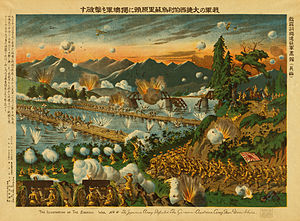Battle of Tsingtao
| Siege of Tsingtao | |||||||
|---|---|---|---|---|---|---|---|
| Part of Asian and Pacific theatre of World War I | |||||||
 A Japanese lithograph of the siege. |
|||||||
|
|||||||
| Belligerents | |||||||
|
|
|
||||||
| Commanders and leaders | |||||||
|
|
|
||||||
| Strength | |||||||
|
Land: 23,000 Japanese infantry 1,500 British infantry 142 artillery pieces Sea: 1 seaplane carrier 5 battleships 2 battlecruisers 2 destroyers Air: unknown aircraft |
Land: 3,650 German infantry 100 Chinese police 324 Austro-Hungarian crew of the Kaiserin Elisabeth Sea: 1 protected cruiser 1 torpedo boat 4 gunboats Air: 1 aircraft |
||||||
| Casualties and losses | |||||||
| 727 killed 1,335 wounded 1 destroyer sunk 1 protected cruiser sunk 1 battleship damaged 1 aircraft destroyed |
199 killed 504 wounded 3,400 captured 1 protected cruiser scuttled 1 torpedo boat scuttled 4 gunboats scuttled |
||||||
Allied victory
The Siege of Tsingtao, sometimes Siege of Tsingtau, was the attack on the German port of Tsingtao (Qingdao) in China during World War I by Japan and the United Kingdom. The siege took place between 31 October and 7 November 1914 against Imperial Germany. The siege was the first encounter between Japanese and German forces and also the first Anglo-Japanese operation of the war.
Throughout the late 19th century, Imperial Germany joined other European powers in an imperialist scramble for colonial possessions. As with the other world powers, Germany began to interfere in Chinese local affairs. After two German missionaries were killed in the Juye Incident in 1897, China was forced to agree to the Kiautschou Bay concession in Shantung (now Shandong) to Germany in 1898 on a 99-year lease. Germany then began to assert its influence across the rest of the province and built the city and port of Tsingtao, which became the base of the German East Asiatic Squadron of the Kaiserliche Marine (German Navy), which operated in support of the German colonies in the Pacific.
Britain viewed the German presence in China as a threat and leased Weihaiwei, also in Shantung, as a naval port and coaling station, while Russia leased its own at Port Arthur (now Lüshunkou) and France at Kwang-Chou-Wan. Britain also began to forge close ties with Japan whose developments in the late 19th century mirrored that of the European imperialist powers and Japan acquired colonial footholds on the Asian mainland. Japanese and British diplomatic relations became closer and an Anglo-Japanese alliance was signed on 30 January 1902. This was seen as necessary, especially by Japan as a deterrent its main rival, Russia. Japan demonstrated its potential by its victory in the Russo-Japanese War 1904–1905 and the alliance continued into World War I.
...
Wikipedia
